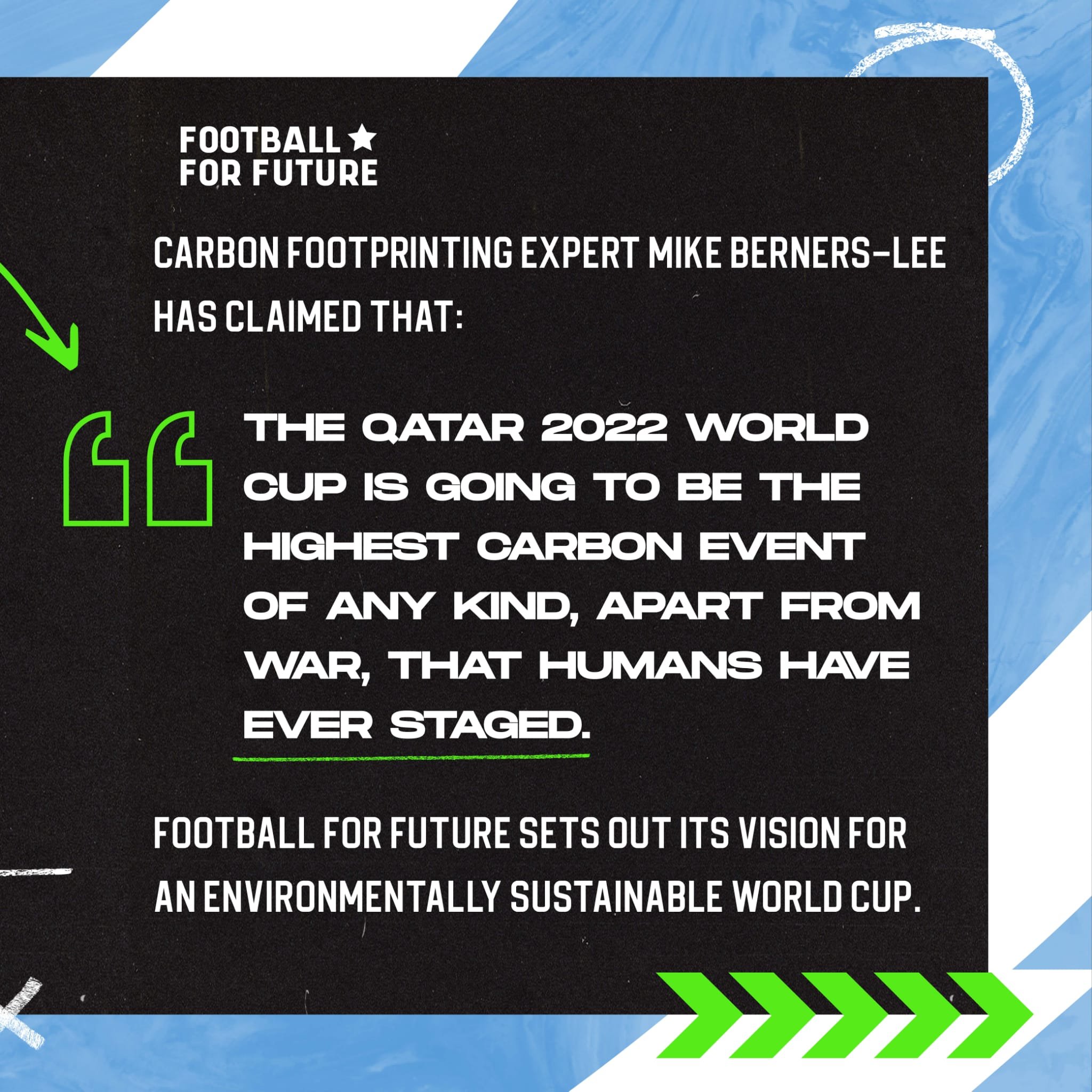FFF Visions: An Environmentally Sustainable World Cup
We love the World Cup. The assembly of teams from all over the world, each with the possibility of glory, temporarily hypnotises football fans from every corner of the planet. The 2018 World Cup attracted 3.5 billion viewers, and Qatar 2022 is expected to reach 5 billion. Football is universal and the World Cup is its greatest stage.
However, we cannot ignore that the environmental impact of the World Cup is monumental. Carbon footprinting expert Mike Berners-Lee has claimed that “the Qatar 2022 World Cup is going to be the highest carbon event of any kind, apart from a war, that humans have ever staged.” The footprint of a World Cup is caused mainly by construction and travel, both inherent to the nature of a sporting megaevent which draws upon vast quantities of high-carbon construction materials in preparation to host millions of international visitors.
The challenge is well understood. But what are the solutions? In this blog, Football For Future sets out a vision for an environmentally sustainable World Cup.
1: Construction-free World Cups
World Cups should not require any new construction, unless there is a clear long-term public need for new sustainable stadiums, transport and accommodation.
Typically, construction is one of the main causes of a World Cup’s eye watering carbon footprint. The majority of this carbon is ‘embodied’ within building materials like steel and concrete, which cause carbon as they are extracted, processed and transported.
Hosting a World Cup usually means building 5-10 new stadiums. Of the 42 stadiums used in men’s World Cups between 2010-2022, 28 were newly built. Seven of these are in Qatar.
New stadiums should be for life, not just for a Christmas World Cup. Qatar 2022 have planned for every new stadium to continue to be used. Some will host the men’s and women’s national football teams. Others are due to be converted into community centres and medical hubs. However, Carbon Market Watch, an industry watchdog, has pointed to “a lack of evidence that the stadiums built for the 2022 World Cup will continue to be used effectively and optimally after the event”.
Construction carbon can most easily be avoided by making use of existing stadiums. This will be the case at United 2026, which is the expanded 46 team World Cup due to take place across the USA, Canada and Mexico. All stadiums proposed to host matches are “already built and operating.”
Where new sustainable infrastructure is required, such as stadiums, transport and accommodation, this should always be in line with existing development plans and public need - and never just for a month-long tournament.
2. ‘Drag and drop’ stadiums
Reusable stadiums that can be dragged and dropped from tournament to tournament should be used to meet temporary stadiums needs.
All too often, once the final whistle is blown, World Cup stadiums become ‘white elephants’ - a phrase meaning something that is big, expensive, useless and difficult to deal with.
A report by Engineers Against Poverty highlights how major sporting events in the last 15 years have left an unwanted “legacy of white elephant projects”, as a result of unused stadiums and neglected transport infrastructure. In Brazil, 4 of the stadiums newly built for the 2014 World Cup now sit empty in cities, too big for the communities in which they were constructed.
‘Drag and drop’ stadiums can be a solution. Imagine a stadium that’s used for the duration of a World Cup, broken down, dragged and dropped in a new city, and rebuilt in time to host a different tournament. You could end up sitting in the same seat in the same stadium, several years apart, on the opposite side of the world.
A ‘demountable’ stadium, made of shipping containers, is one of Qatar 2022’s major sustainability innovations. Unfortunately, it takes twice as much carbon to make one of these, and there are currently no plans for it ever being reused elsewhere.
3. World Cup carbon bootprints
A consistent approach to calculating the carbon bootprint of World Cups should be established to avoid questionable claims.
There is no agreed method for calculating the carbon footprint of a World Cup. This means that the reported carbon footprint for any World Cup tournament needs to be taken with a pinch of salt, because each might use different approaches and include different things. It also means that it’s impossible to accurately compare the true carbon impact of tournaments.
Carbon Market Watch have claimed that Qatar 2022’s stated construction carbon footprint is massively underestimated. This is partly because the carbon has been calculated on the premise that the stadiums aren’t being built solely for the World Cup. Given that the stadiums have a projected lifespan of 60 years, only a small portion of the total carbon emitted has been attributed to the tournament itself.
This approach is commonly used in construction to effectively ‘stretch’ the reported carbon over the whole lifetime of the infrastructure, instead of reporting it all at once, on the basis that it’ll be used for many years to come.
4. Carbon in the bidding process
Carbon should become a fundamental criteria of the World Cup bidding process
It all starts with the World Cup bidding process. Once bids are submitted by potential hosts, FIFA assess them and write their findings in a ‘bid evaluation report’. This is provided to member nations who then vote on their preferred bid. FIFA does require a carbon footprint to be completed as part of this process, but largely ignores the environment across its scoring criteria.
Within their bid, United 2026 reported 3.7 million tonnes of carbon, making it the highest World Cup carbon footprint ever. Travel accounts for 85% of these emissions. However, FIFA’s evaluation report rated transport as low risk, citing the “combination of excellent international accessibility and intercity air connectivity” and ignoring the monumental carbon impact.
Similarly, FIFA’s evaluation report for Qatar 2022 uncritically promoted it as a ‘carbon-neutral’ World Cup, while highlighting stadium construction as a concern only in relation to the “operational readiness” of stadiums.
By embedding carbon as a genuinely meaningful consideration within the bidding process, FIFA can incentivise potential World Cup hosts to truly address the carbon impacts of international travel and construction. Doing so should also encourage FIFA to begin to ask fundamental questions about the appetite for ongoing tournament growth and continental-scale expansion, against a backdrop of the climate emergency.
5. Environmental legacy
The universal platform of the World Cup should be harnessed to raise climate awareness and drive the transition to a sustainable, net zero society.
Legacy is an important term when it comes to hosting a World Cup. It refers to the desire of the host nation or nations to have the tournament leave a lasting impact, once it’s all over.
Football has a unique ability to capture imaginations, unite communities and change society. It is a universal language with immense power and influence. Footballers are the most followed athletes on social media - other sports don’t even come close.
The World Cup is the greatest stage on which to harness this power, and we must not simply ‘stick to the football’. To do so is active acceptance of existing political and social crises. The opposite is necessary.
By making climate and sustainability a foundational principle of future tournaments, including decisions on sponsors and partners, the platform of the World Cup can be utilised to drive the climate conversation, promoting education, awareness and a transition to a net zero, sustainability society and economy.
Final Word
According to the IPCC, humanity must significantly reduce carbon emissions this decade to avoid irreversible damage to our climate system. Despite this, 2021 saw the second biggest rise in greenhouse gas emissions on record. We are in extra time. Football For Future (FFF) is an environmental non-profit made up of sustainability experts, climate scientists and football-creatives, with a mission to build a more environmentally sustainable culture in football.


